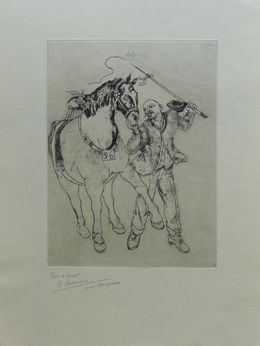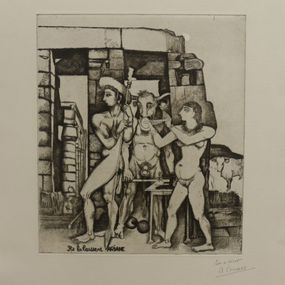
Presentation
Alfred Courmes is a French painter born in Bormes-les-Mimosas on May 21, 1898 and died in Paris on January 8, 1993. After his secondary studies in Monaco, his naval officer father encouraged him in his desire to be a painter. A pupil of Roger de La Fresnaye, of whom he was to be the only disciple, Courmes moved to Paris in 1925, and exhibited at the Salon des Indépendants and the Salon d'Automne. He produced cubist canvases: Cubist still life with a brush, in 1921, painted portraits like that of Peggy Guggenheim. He moved to Ostend the following year and met Ensor, Constant Permeke, and Félix Labisse. At the same time, he immersed himself in the paintings of Van Eyck, Hans Holbein, Dürer, Brueghel… while visiting the museums of Bruges and Ghent. In 1929, he painted the Wounded Man in homage to Roger de La Fresnaye. This confrontation between classicism and this surrealist and expressionist vision will be permanent references for Courmes. Nicknamed The Angel of Bad Taste by his detractors, he often diverts in his paintings from mythological (Sphinx, Minotaur, Oedipus) or Christian (Saint Sebastian, Saint Anthony, Christ on the cross) for humorous or sexual purposes, sometimes clearly homoerotic. It is not uncommon for modern objects (bicycles, dumbbells) or contemporary clothing (silk stockings, shorts, sailors' clothes) to be associated with the worlds of Antiquity or the Middle Ages. He also borrows from the imagery of the advertisements of his time (little girl and the Chocolats Menier logo, Michelin Bibendum, laundry packages, Camembert labels) and from the photography of sensational newspapers (bloody murders, criminals, military detachments) to arouse comical or blasphemous anachronisms. In 1930, he moved to Paris and in 1936 received the Paul Guillaume Prize (shared with Tal-Coat) for Saint Sébastien, a typical example of his style. The painting embodies traditional Christian iconography by depicting the saint as a sailor and using references to contemporary advertising: the girl from Chocolats Menier feels the genitals of the saint attached to a tree, while planting a arrow in the side; the whole is surrounded by the blue circle of a Camembert mark which gives information about the painter and his canvas. This success enabled him to obtain an order in 1937, Le Toucher for the pavilion of the Sèvres manufacture at the International Exhibition in Paris. In 1938, Albert Sarraut, Minister of National Education, offered him the wall decoration for the dining room of the French Embassy in Ottawa in Canada and in the company of other artists: one hundred and twenty square meters painted with wax including the theme will be Happy France, which will require two years of work and will end on the eve of the Second World War, it is signed and dated July 21, 1939, 3 am. In 1946, he participated in the Surrealist Exhibition in Lille with Magritte and his friend Clovis Trouille, from 1957, he exhibited regularly at the May Salon and in 1971 during the Les Autres exhibition organized by Yves Hamon in Bordeaux. Courmes is recognized as the precursor of a generation of young painters who exhibited with him at the National Gallery of the Grand Palais in 1972 in the exhibition 12 years of contemporary art, and received the Panique Prize. He will be present at the Mythologies Quotidiennes exhibition at the modern art museum of the city of Paris in 1976, as well as at the exhibition Les Réalismes entre Révolution et Réaction 1919-1939 at the Center Georges-Pompidou. He was named Chevalier of the Legion of Honor in 1991, he lived and painted until his death on January 8, 1993. He was buried in Châtillon-en-Diois.
Read more
All artworks of Alfred Courmes
Discover our selections of works by artists
Need help finding your favorite? Consult our selection pages made for you.
Need to know more?
What are their 3 main works?
When was Alfred Courmes born?
The year of birth of the artist is: 1898

